My friend Sara makes some yumtastic Guatemalan enchiladas whenever I visit. It’s one of the best food in Latin America to eat if you want to sample some Central or Latin American cuisine.
Did you know that almost every Latin American country has its own iconic snacks or traditional South American street food? And eating Latin American food can be as sensual and mind-blowing as dancing to Latin American music.
If you’re traveling through, here are some of the popular foods in South America and Central America to eat, from empanadas and enchiladas to tacos al pastor and tostones.
1. Panuchos in Yucatan
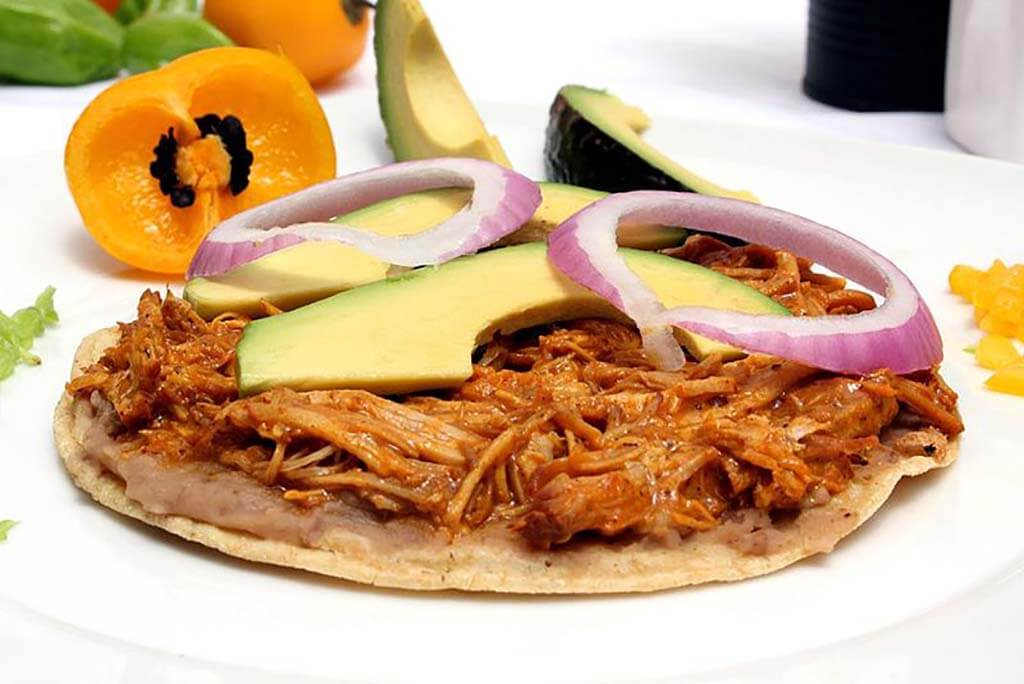
Pic by Canibalazzo from Wiki CC-BY-SA-4.0
Mexican cuisine is one of the most famous cuisines in the world. You can see Mexican restaurants and stores almost in every city, but what you will never be able to do outside Mexico is to actually enjoy the real flavors of every single dish Mexicans created.
Only when we moved to Mexico City, I realized I had never tried Mexican food before. One of my favorite morsels were panuchos.
Panuchos are originated from Yucatan. This state is very well-known for its incredibly delicious cuisines in entire Mexico. The combination of flavors and ingredients, such as achiote, chaya, and corn, have made their gastronomy a real treasure.
A panucho is a corn tortilla that is filled with ground beans and fried. The traditional panuchos are made with roasted chicken, cabbage or lettuce, tomato, avocado, red onion, and pepper, but nowadays you can find them in the local market with Cochinita, Relleno Negro and Lechón al Horno.
Panucho itself was invented for hungry travelers by Don Ucho who owned the small restaurant on the road called Camino Real. It was located just near the Hermitage of Santa Isabel which visited lots of tourists.
Don Ucho used to serve them a loaf of bread with bean spread, however, once he ran out of the bread and served the spread on a tortilla. This was the beginning of famous panuchos that became a part of the history of the gastronomy in this wonderful state.
To experience true Mexican cuisine, book this amazing food experience during your stay in Mexico.
By Ana, Santi & Teo from Parenthood 4 Ever
Catch up with Parenthood 4 Ever on Facebook here!
2. Enchiladas in Guatemala
By Sara who gave us her recipe for Enchiladas
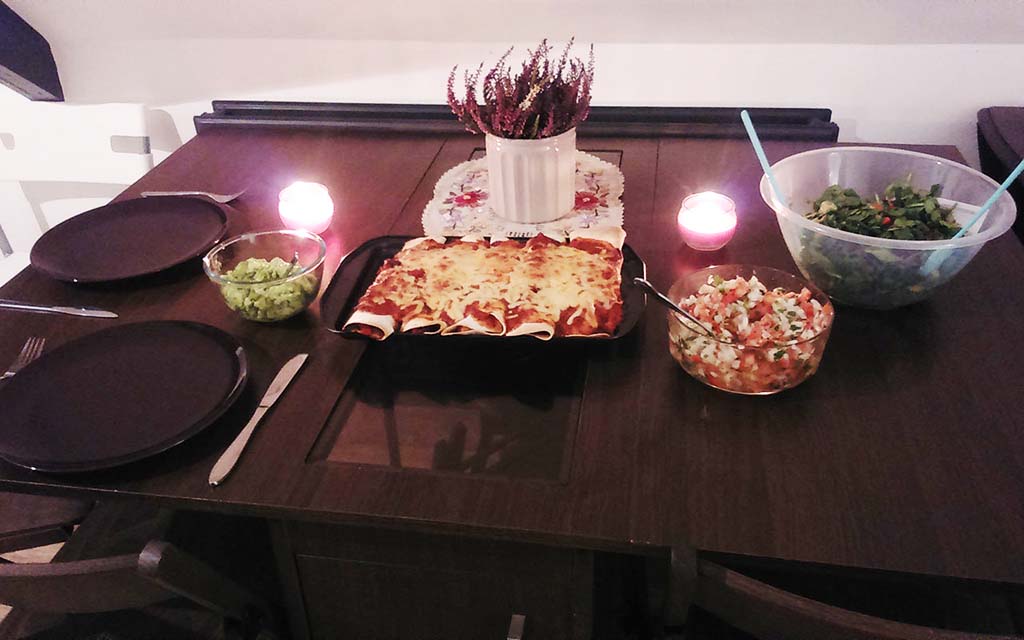
Enchiladas are a typical Latin American dish dating back to the 18th century and originating in Mexico. There is some debate as to which enchiladas belong to which community; with people often saying that the soft rolled tortillas filled with ingredients and covered with cheese are the Mexican version while the open-topped tostadas are the Guatemalan version. But being Guatemalan, I say both originated in my own country.
Back home, we make both varieties of this traditional Latin American dish. And I really love letting my enchilada get soggy before eating it, just like my friend Abby does. When the corn tortilla roll soaks up all the juices from the enchilada filling and the sauce, it’s heaven.
Enchiladas take quite some time to make and require quite a few ingredients. For the filling, I use ham and chicken, mozarella cheese, and a host of veggies that you’ll find in my enchilada recipe.
Enchiladas can be eaten on their own, but I prefer to cook them along with guacamole and a nice spicy salsa. If you visit my home country of Guatemala, or literally any place in Latin America, try the enchiladas. You’ll definitely go back for more the next day!
3. Lomo Saltado in Peru
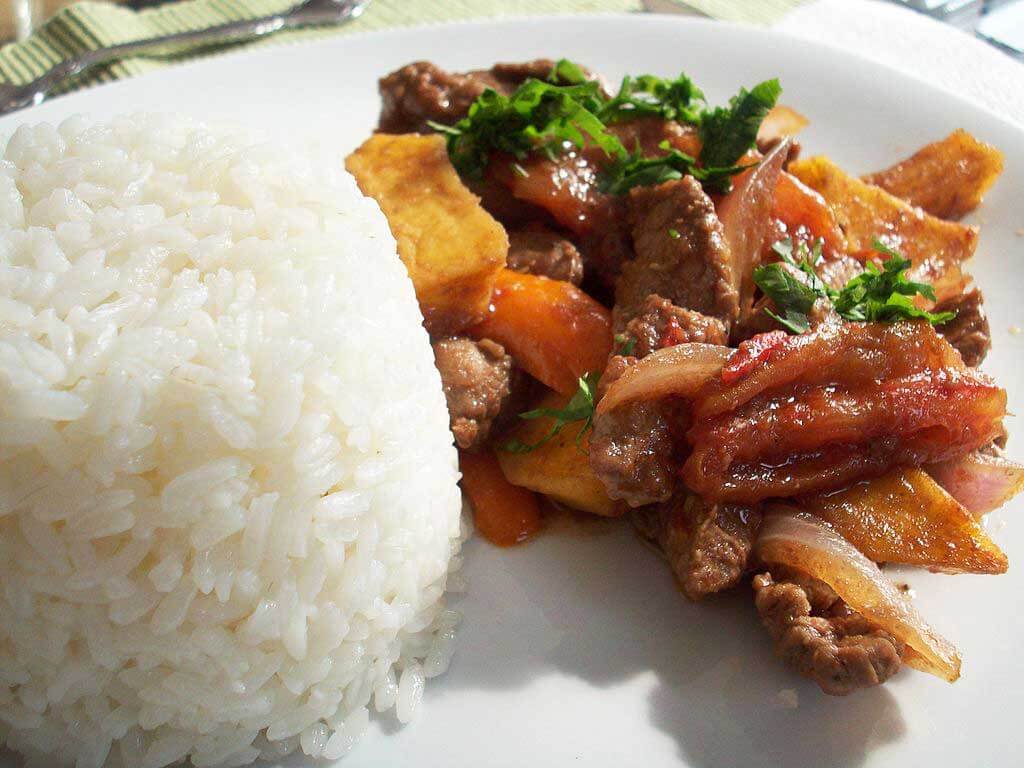
Pic by HugoMon from Wiki Commons CC-BY-3.0
When visiting Peru, you may be surprised to find out (as I was) that the country has a large Chinese influence. Especially in Lima, where Chinese immigrants have been making the Peruvian coast their home since the late 19th and early 20th centuries.
With the arrival of Chinese immigrants came a shift in the culinary scene. Chifa, as it is known in Peru, is a culinary tradition of food fusion between Chinese elements and Peruvian ingredients.
You notice Chifa restaurants all over Peru, and it is quite common to have at least a couple Chifa-inspired dishes on most menus. The most famous of these dishes, of course, being Lomo Saltado.
Lomo Saltado is an extremely popular stir fry that traditionally includes strips of beef mixed with peppers, onions, and potato fries (yup, mixed right in). The dish is typically served with steamed white rice. And boy, let me tell you it is delicious!
And the best part is lomo saltado is an extremely affordable dish. Even in Lima, where some of the best restaurants in Miraflores can cost you A LOT, you can still find an amazing lomo saltado for between 10 and 40 soles (the equivalent of $3 to $12). You can learn more about Peruvian cuisine at this cooking class.
By Kara from Happening in Denver
Catch up with Kara on Twitter here!
4. Bake in Guyana
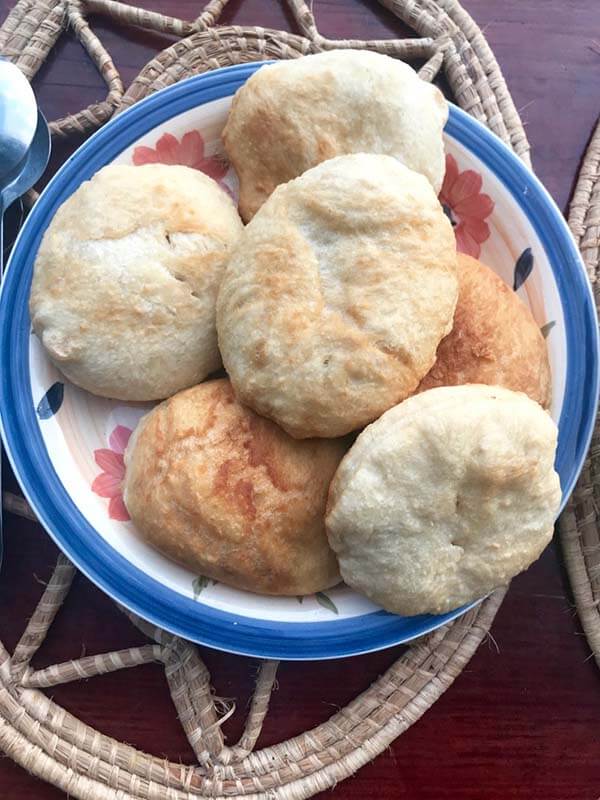
Pic by Cacinda from Points and Travel
Bordered by Brazil to the south, Venezuela to the west, and Suriname to the east Guyana is a unique cross-cultural exchange of many nations.
It is a melting pot of age-old cultures, traditions, and flavors coming from Africa, Britain, the Caribbean, China, Dutch, India, and as far away as Portugal. But one thing you will find in almost every kitchen in Guyana is something called BAKE.
Bake is a soft, deep-fried, semi-sweet puff of bread that seemed to make its way to Guyana by way of the islands of the Caribbean.
Traditionally, it is sliced in half and stuffed with all kinds of things that could be sweet, salty, or even spicy. It appears to be the main vehicle for many standout dishes in Guyana.
Guyanese put everything in it from egg and bacalhau (a Portuguese dish made from salted cod, fried potatoes, and onions bound to the scrambled eggs) to warm chickpeas and potato curry to minced salted cod.
But save room for your sweet tooth, as they can also stuff it with Nutella, blackberry jam or I have even seen them mix the two! I’ve also seen it served stuffed with chocolate truffles and confectioner’s sugar. You can think of BAKE like a homemade HOT POCKET!
Also fried Bake with Salt fish is the quintessential breakfast of almost all Guyanese. They even call them Guyanese Bakes or Floats throughout Guyana. So basically they are breakfast sandwiches!
However, don’t forget that Bake is really delicious served alone. As it is sort of a cross between fried monkey bread and an English muffin in texture. Of course, I loved it! You should think of BAKE as the kind of bread that can basically be eaten with almost anything.
By Dr. Cacinda from Points and Travel
Catch up with Points and Travel on Instagram here!
5. Flautas in Mexico
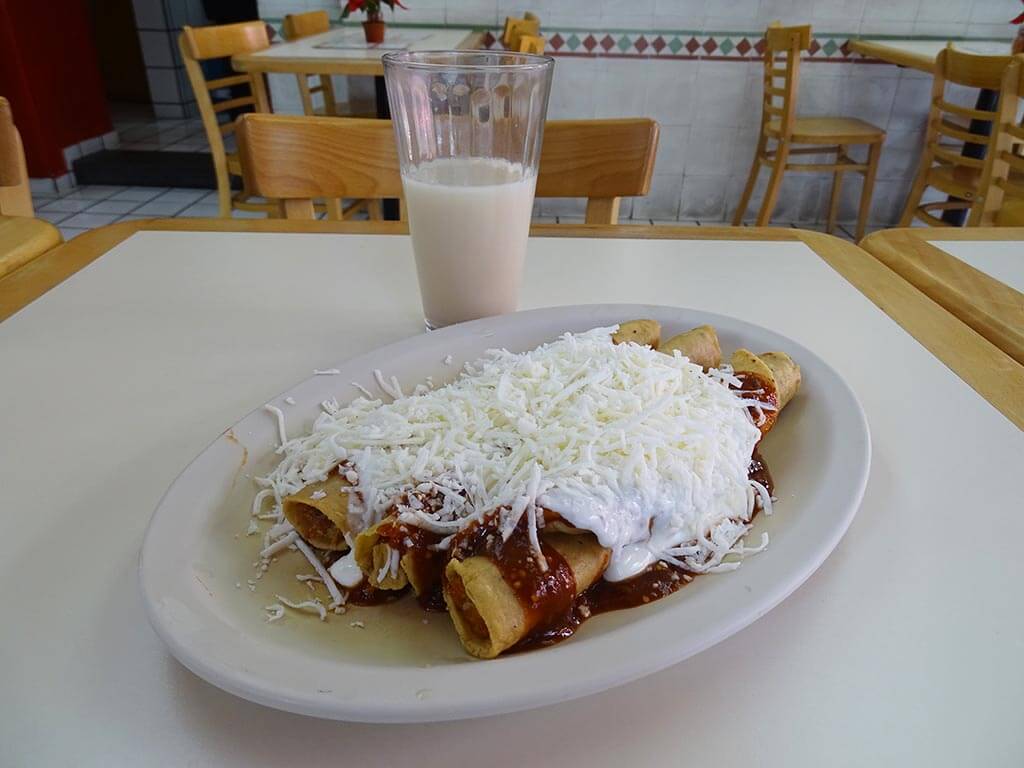
Pic by Rose from Where Goes Rose
Some of the best Mexican foods are known around the world, however this isn’t the case for flautas. This delicious dish isn’t known to many travellers from Europe, although Americans may be able to compare them to chimichangas (although these are made with wheat instead of corn). Either way, you’ll want to fry the real deal when visiting Mexico!
Made with the country’s staple ingredient corn, flautas comprise masa (corn dough) spread out like a taco, then rolled up into flute shape and deep-fried. The word flauta in Spanish actually translates as flute.
Flautas come stuffed with ingredients of your choice, commonly mashed papas (potatoes), cheese or meat stewed with salsa roja or verde (red or green sauce).
When you order flautas in a restaurant, they’ll usually come in servings of three, topped with lettuce, cream and cheese. Cream on a savoury dish may sound odd but it’s a popular ingredient in Mexico and tastes more like soured cream than sweet.
The northern state of Sinaloa is thought to be the original home of flautas but now they’re popular around the country. Mexico City, famed for its incredible street food, is a great place to eat flautas from street stalls or modest family-run restaurants.
By Rose from Where Goes Rose
Catch up with Where Goes Rose on Facebook here!
6. Brazilian Carrot Cake

Pic by Bruna from I Heart Brazil
Fluffy and nicely moist, Brazilian carrot cake tastes like more. If you and your family are fans of carrots, moist cakes, and chocolate, this Latin American dessert is right up your alley!
Put simply, Brazilian cake has a beautiful yellow bright dough covered with a chocolate icing made of our favorite dessert – brigadeiro!
Did I convince you yet?
Very popular throughout Brazil, this blender carrot cake (Portuguese: bolo de cenoura) is very easy and fun to make.
Namely, you’ll only need a few tools – a bow to mix the dough and a blender. It can’t get any easier than that!
Beyond that, it is not a secret that Brazilian food is hearty and yummy, and thankfully, this cake lives up to this fame.
If I may give you a few recommendations, do serve this carrot cake with freshly brewed coffee. Oh, what a perfect combination! It tastes ridiculously delicious!
Alternatively, you can always serve it with tea, if you’re a tea person. Still, coffee enhances the carrot and chocolate flavors better.
Speaking from experience, this cake adds a South American touch to any afternoon snack, and more often than not, the crowds love this Brazilian cake.
By Bruna from I Heart Brazil
Catch up with I Heart Brazil on Facebook here!
7. Guinea Pigs in Peru
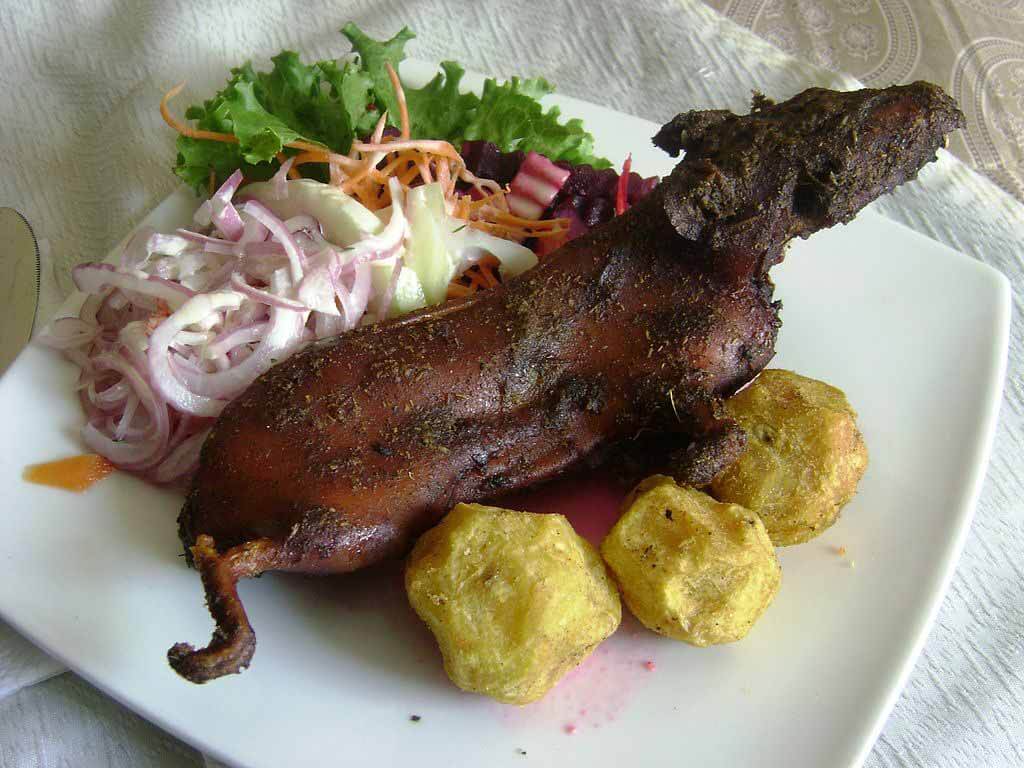
Pic by Dtarazona from Wiki Creative Commons CC0 License
If you were one of those kids who had a guinea pig growing up, maybe skip over this one! Cuy is a dish in Peru which refers to roasted or fried guinea pig. It’s a hugely popular “adventure” dish with tourists, but is also part of the regular local diet for many Peruvians.
While it doesn’t look particularly appetizing (a far cry from a nicely roasted pig or chicken) the smell when they’re roasting away on the grill is quite delicious. And what about the taste? Very lean, bony, quite gamy, but super flavorsome if cooked well.
If you don’t want to deal with looking at a cute little guinea pig on your plate, the restaurant can cut it into bits before serving it to you. Being a local delicacy, cuy is very easy to find throughout Peru. Give it a try!
By Bren from Bren On The Road
Catch up with Bren On The Road on Facebook here!
8. Tostones in Central America
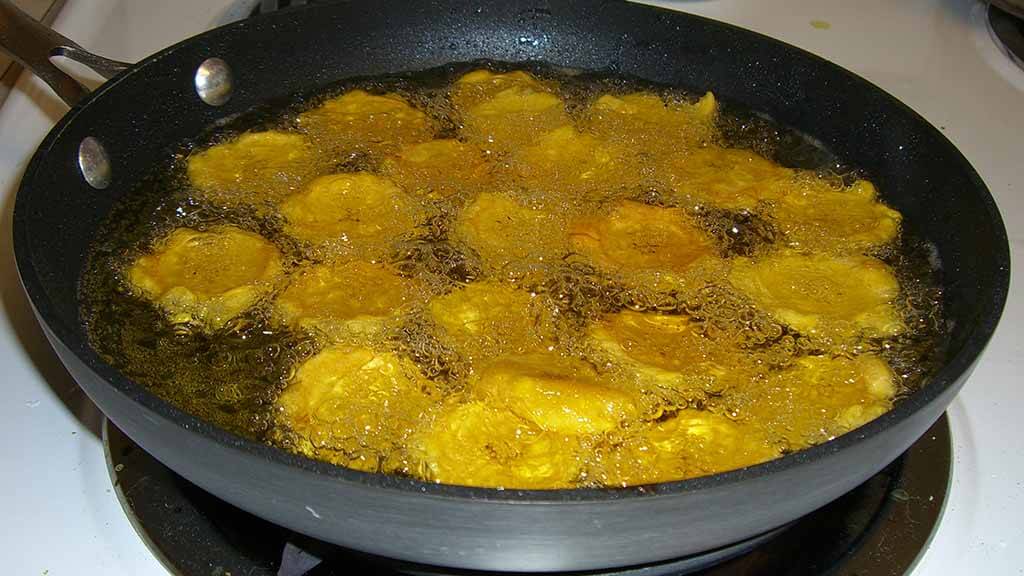
Pic by Dozenist from Wiki Commons CC-BY-SA-3.0
Tostones are a popular side dish in Nicaragua and usually called patacones in Costa Rica and Panama and quite a few other names throughout Latin America and the Caribbean, but they are the same thing: fried plantains.
There are two ways plantains are usually served: sweet and fried. Tostones are the fried version. They are sliced green (unripe) plantains that are fried on both sides, then patted dry and pounded flat and salted to serve.
The origin isn’t entirely clear, but they are thought to have originally come from Puerto Rico from the chef Doña Angelina. They are usually eaten as a snack or side dish similar to potato chips or fries.
Occasionally they are served with aji, a type of hot sauce. In some places, they are served as a side to fish, others they are topped with seasoned shredded beef or cheese and even with shrimp ceviche.
They are pretty versatile and can easily be made at home and sometimes bought at the store. You can learn more about Puerto Rican food with this streefood tour.
By Megan from Red Around The World
Catch up with Red Around The World on Facebook here!
9. Bandeja Pais in Colombia
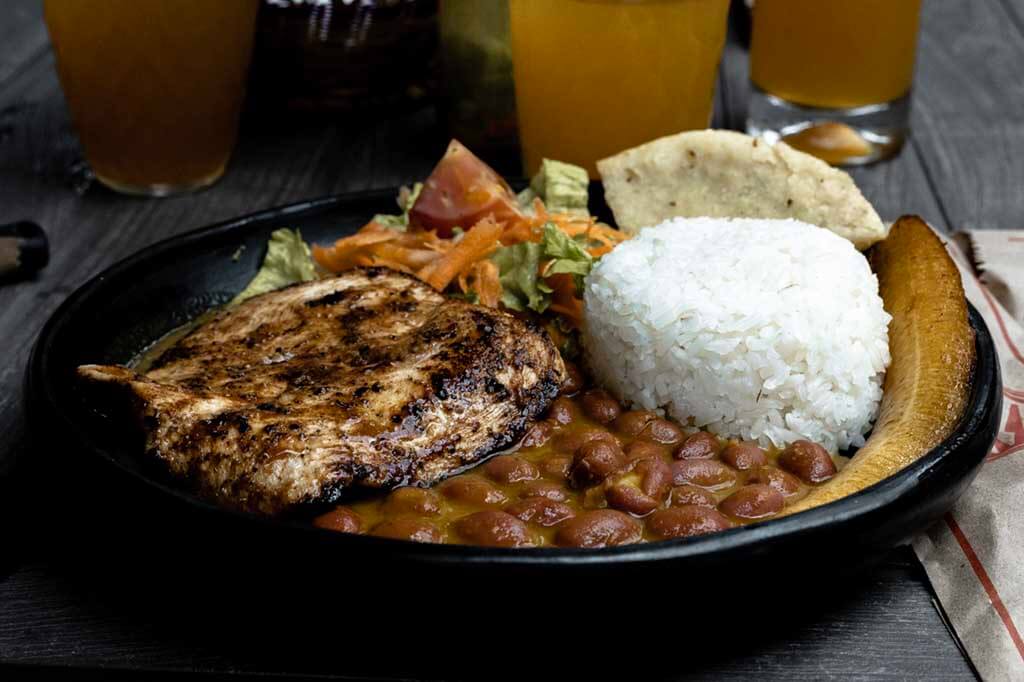
Pic by Jodie from Ala Jode
Bandeja Paisa is an important dish in Colombia, and a common Colombian food in the country’s Paisa region. It is its geographical origin that gives the dish its name and the literal translation is ‘Paisa platter’.
Its name also gives away exactly what bandeja paisa is: a large platter covered in a spread of local favourites. Although every bandeja paisa will be a little different, it generally includes beef, at least one type of Colombian chorizo, rice, beans, avocado, salad, plantain and a fried egg. Many restaurants also offer chicken or vegetarian options, too.
If you’re thinking that sounds like a lot of calories – you’d be right! Bandeja paisa was originally a dish that farmers in Colombia’s Antioquia region would eat before working the fields. It’s packed with protein and carbs to keep them going all day.
Given that it was eaten by farmers, it also began as an affordable meal for peasants. Nowadays, it’s a staple dish in Colombia and a popular food to try for tourists visiting the country. You’ll have no problem finding it in the Antioquia region of Colombia because pretty much every restaurant sells it!
By Jodie from Ala Jode
Catch up with Ala Jode on Facebook here!
10. Acarajé in Salvador
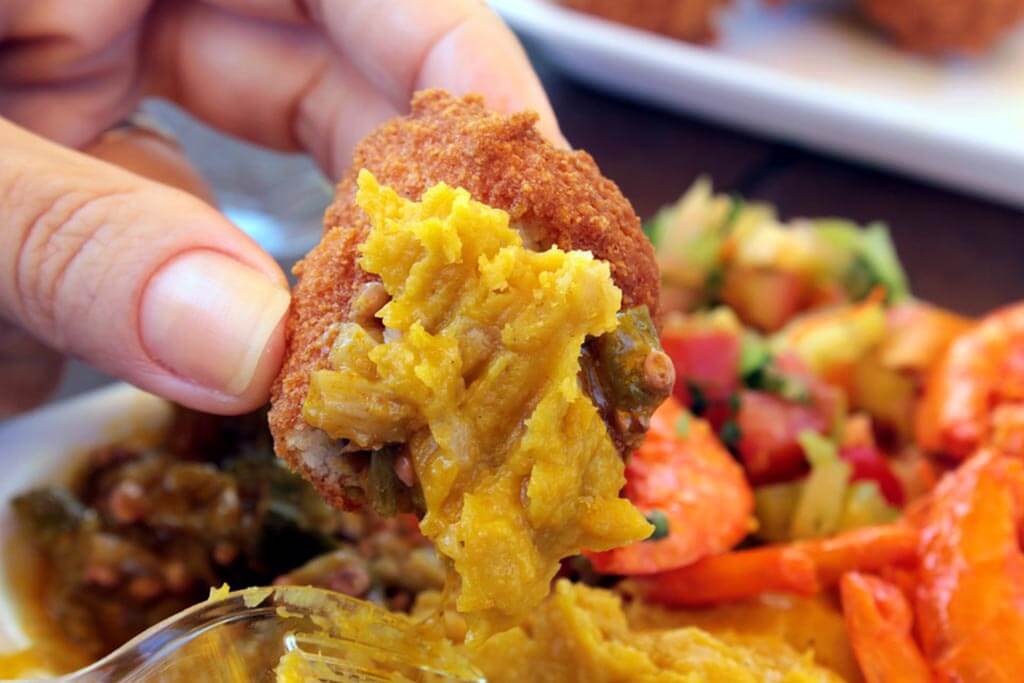
Pxabay Pic by Gadini
Acarajé is one the most popular street food of Salvador (capital of the State of Bahia, north-east Brazil), but, more than that, it represents an icon of cultural identity.
Salvador was the first colonial capital of Brazil founded by Portuguese settlers in 1549. Salvador was also central to slave trade with thousands of African slaves arriving in the city in the 1500s.
Fast forward many centuries later, the colorful colonial buildings are still everywhere in the Historic Centre and African influences can also be seen everywhere on the streets of Salvador.
You don’t need to walk for long around the city to come across Acarajé street vendors – often dressed up in traditional outfits. The scent will probably get to you before you see this colorful dish.
But how are they made? Acarajé are fritters made with black-eyed peas, fried in traditional dendê oil (a type of palm oil) and filled with different toppings, shrimps with hot sauce being the most traditional.
Apart from Brazil and confirming its connection with Africa, this dish (or close variations of it) can also found West African countries such as Nigeria, Ghana, Togo, Benin, Mali and Gambia. For those who love to try local authentic cuisines, Acarajé is a culinary icon of Northeast Brazil – a must try dish!
By Silvia from Mums Delivery
Catch up with Mums Delivery on Facebook here!
11. Chilaquiles in Mexico
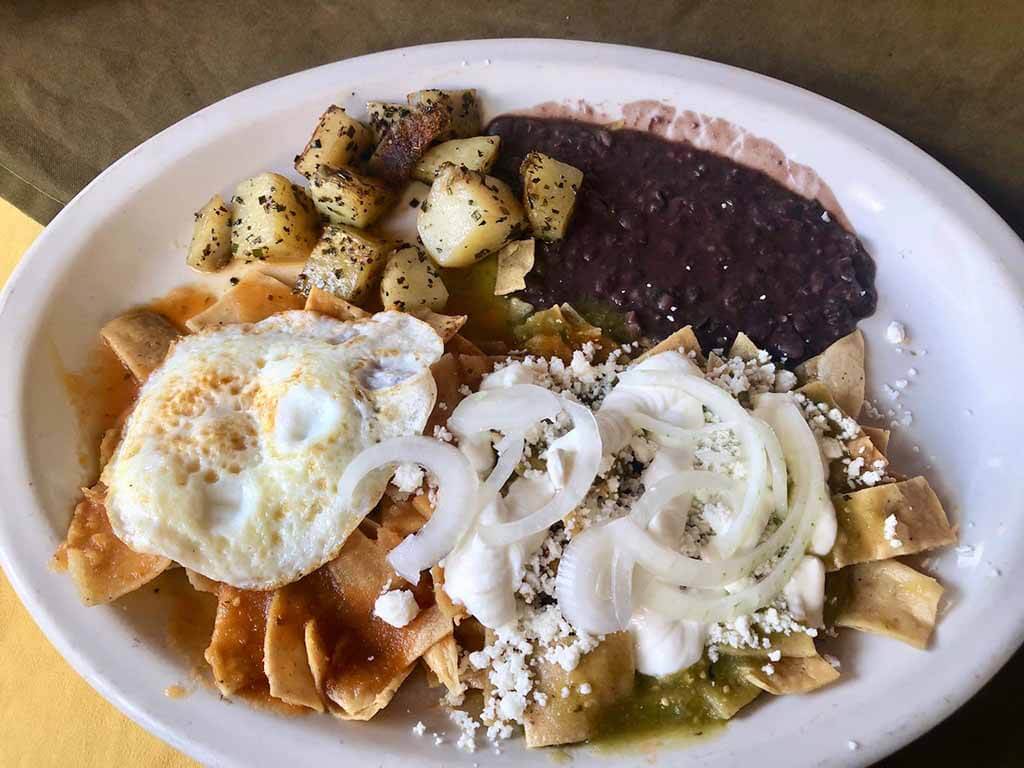
The first time I tried Chilaquiles, I was at a little family-style breakfast cafe in Punta de Mita, Mexico. When the waitress came to take my order, she suggested Chilaquiles and when I asked what they were, she simply said, “You’ll love them.” She was right.
Chilaquiles are a traditional Mexican brunch food intended to use up leftover tortilla chips and salsa. To make Chilaquiles, leftover corn tortillas are sliced up and simmered in red or green salsa. This allows the chips to absorb those delicious spices and flavors.
You can top them off with a sprinkle of cheese, or get more creative by adding beans, eggs, and other toppings. Chilaquiles are the ultimate comfort food and a must-try dish if you’re traveling in Mexico.
By Nicola from See Nic Wander
Catch up with See Nic Wander on Facebook here!
12. Asado and Parillada in Buenos Aires
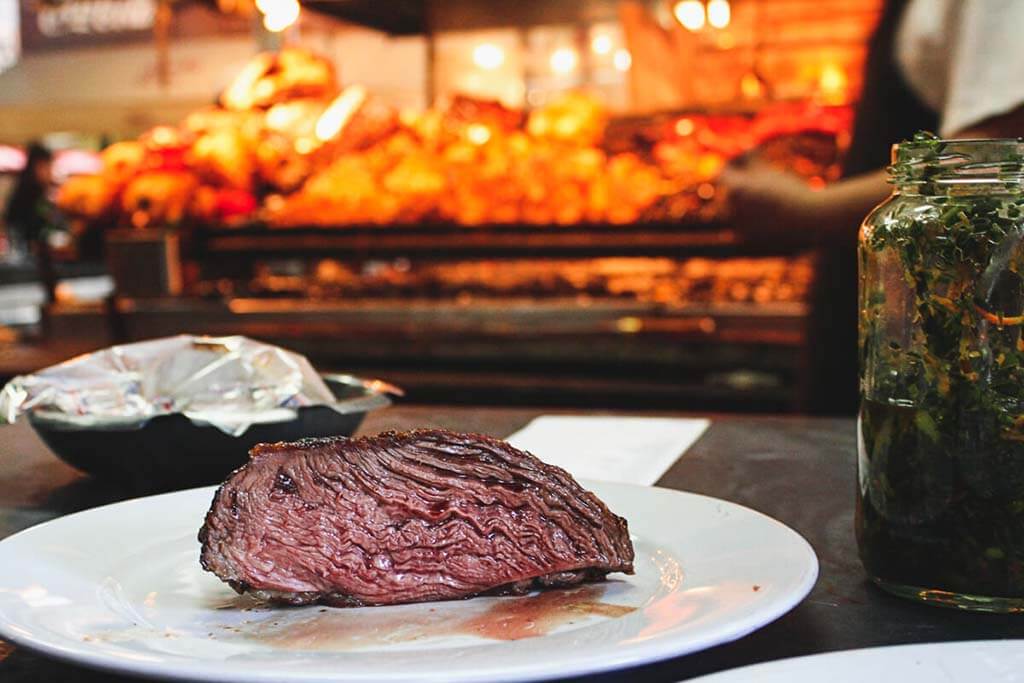
Pic Erin from Sol Salute
There is nothing more ubiquitous in the Argentine diet than red meat. Argentina has an important rural culture, with their very own cowboys, called gauchos, and ranches that dot the landscape. Naturally, meat would feature heavily in their diets.
Looking for the best steak in Buenos Aires? Eat at the city’s countless parillas, the local name for a steakhouse.
The most popular cuts are lomo (tenderloin), bife de chorizo (sirloin) and tira de asado (ribs). If you’re not sure what cut to order, go all out and order a parillada to share with the table.
Your waiter will bring out a small grill overflowing with a variety of meats to the table. This little grill will keep the meat hot as you make your way through more meat than you ever thought possible to consume in one sitting (so come with a group of hungry friends!).
If you have any local friends in Argentina, the absolute best way to consume meat is by attending an asado, or barbeque. Friends and family gather every weekend for a long, drawn-out meal shared over wine and steak.
Argentines consume twice as much meat per year as North American countries, so however you choose to consume your Argentine steak, you’ll be in good company eating some of the best beef in the world. Go on this food walk to feast on delicious Argentinian meat dishes.
By Erin from Sol Salute
Catch up with Sol Salute on Facebook here!
13. Gallo Pinto from Costa Rica
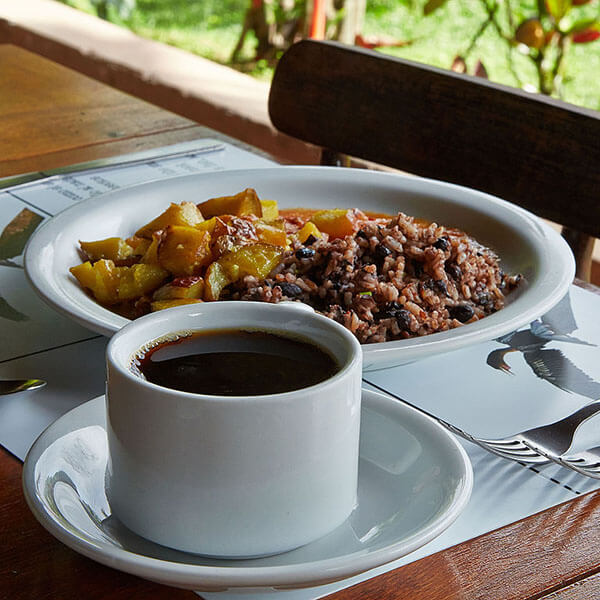
Pic by C T Johansson from Wiki Commons CC-BY-3.0
Gallo pinto is one of the most traditional and famous vegetarian meals from Costa Rica. The name ‘Gallo Pinto’ translates as ‘spotted rooster’, which is believed to be due to the speckled color you get when you mix its two main ingredients – black beans and rice – together.
Its history is debated to be from either Costa Rica or its neighbour Nicaragua, but is most commonly said to have been invented in the 1930s in San Jose.
It is a hearty dish that’s as nutritious as it is delicious, blending all of the best local ingredients – black beans, white rice, spices, peppers, onions and a fragrant Costa Rican sauce, Salsa Lizano.
Though Costa Rican cuisine is known for being fairly mild, you can add as much spice as you like when you make it at home to give it an extra kick.
Though its origins are contested, one thing that isn’t is its popularity… You’ll find it on nearly every breakfast table in the country, from local homes and hotel buffets.
It’s also almost always on the menu at sodas (Costa Rican cantinas) and traditional restaurants too. You might find it served with eggs, avocado, corn tortillas or plantain, so you better be hungry!
By Anna from Would Be Traveller
Catch up with Would Be Traveller on Facebook here!
14. Pozole in Mexico
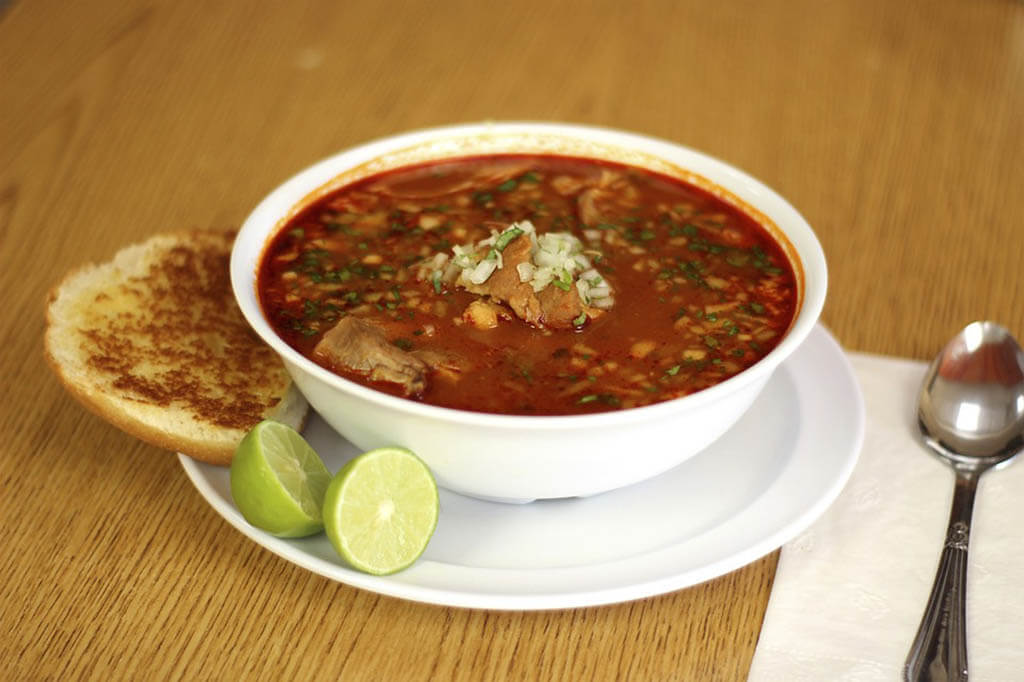
Mexican food easily is the best one in Latin America, with the most varied cuisine and the use of an incredible array of ingredients. It’s so unique, that Mexican cuisine is actually UNESCO enlisted.
The list of dishes you should try in Mexico would be too long to share. One you really should not miss is pozole, a dish that is in-between a thick soup and a stew.
Though you will find it all over the country, the dish is more typical of the states of Guerrero, Morelos and Jalisco, and you will also see on the menu in the Distrito Federal.
Pozole is made with large chunks of meat (typically pork), hominy (whole corn), raw lettuce, raw sliced radish and chopped onions. It is served with dry herbs such as oregano and chili peppers, and with massive amounts of tajadas – tortilla chips which in Mexico are nothing more than leftovers tortillas cut in triangles and toasted or fried.
For a slightly healthier version of pozole, you may want to try one with zucchini flowers and mushrooms. It’s lighter, yet full of flavor and delicious.
By Claudia from My Adventures Across The World
Catch up with My Adventures Across The World on Facebook here!
15. Sopa Paraguaya in Paraguay
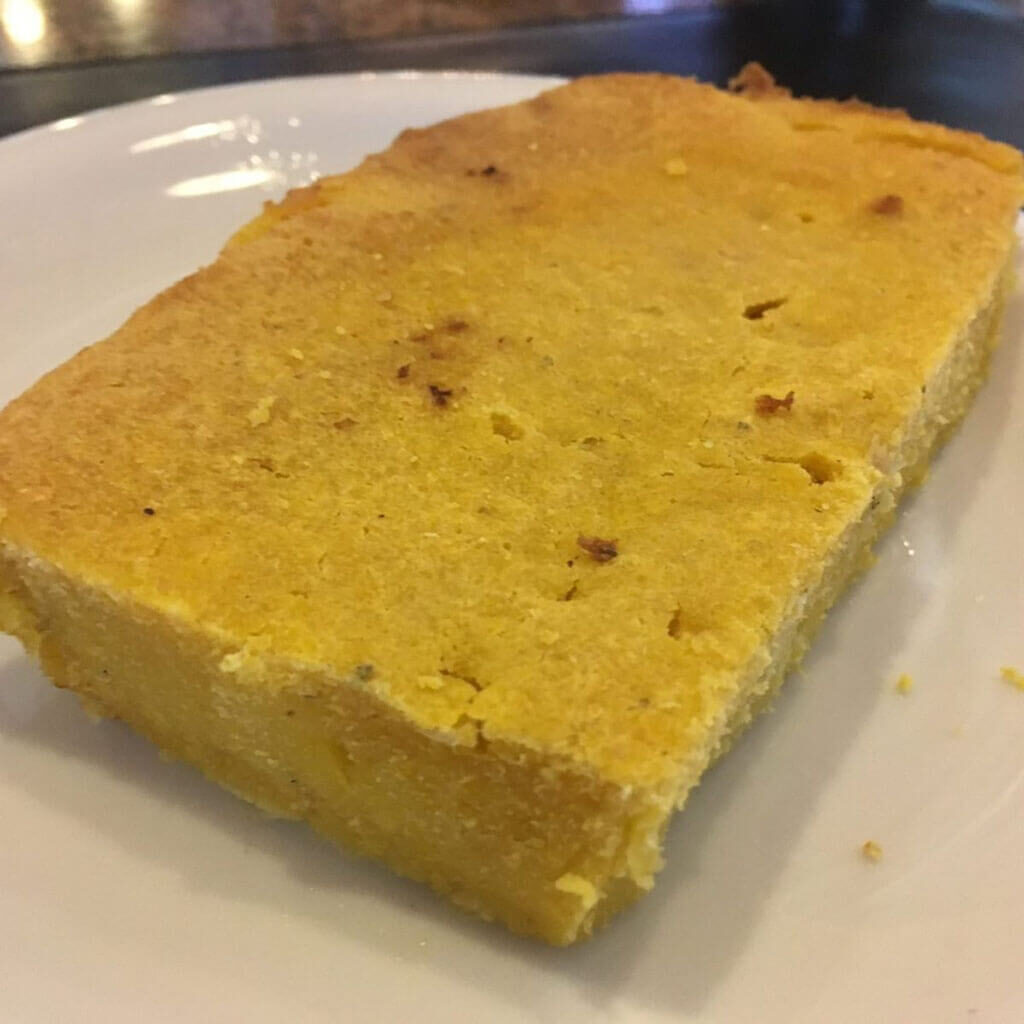
Pic Wendy from The Nomadic Vegan
Paraguay is not really known as being a top destination for foodie travelers. In fact, it’s pretty off-the-beaten-track regardless of what kind of traveler you are. And while it may not be a foodie paradise, there are certainly a few local specialties to try that you won’t find anywhere else. One of these is sopa paraguaya.
The name means “Paraguayan soup”, but that doesn’t tell the whole story. While this dish certainly is from Paraguay, you’ll be surprised to learn that it’s not a soup at all!
The dish that it resembles the most is cornbread, and it’s made from a mix of corn flour, onions, milk, eggs and cheese.
These ingredients show influences from both the indigenous Guaraní people and the Spanish colonizers. While corn was a major part of the traditional Guaraní diet, it was the Spanish who introduced the consumption of milk, eggs and cheese.
Although if you don’t eat these ingredients, or you’d just like to try a decolonized version of sopa paraguaya, there’s a restaurant in Asunción called Bolsi that makes a healthier, vegan version of this and other Paraguayan dishes.
As for why it’s called “sopa”, the story goes that the President’s cook accidentally added too much corn flour to his favorite soup and didn’t have time to make a new batch. So instead, she baked it in the oven and turned it into a “solid soup”.
By Wendy from The Nomadic Vegan
Catch up with The Nomadic Vegan on Facebook here!
16. Pão de Queijo in Brazil
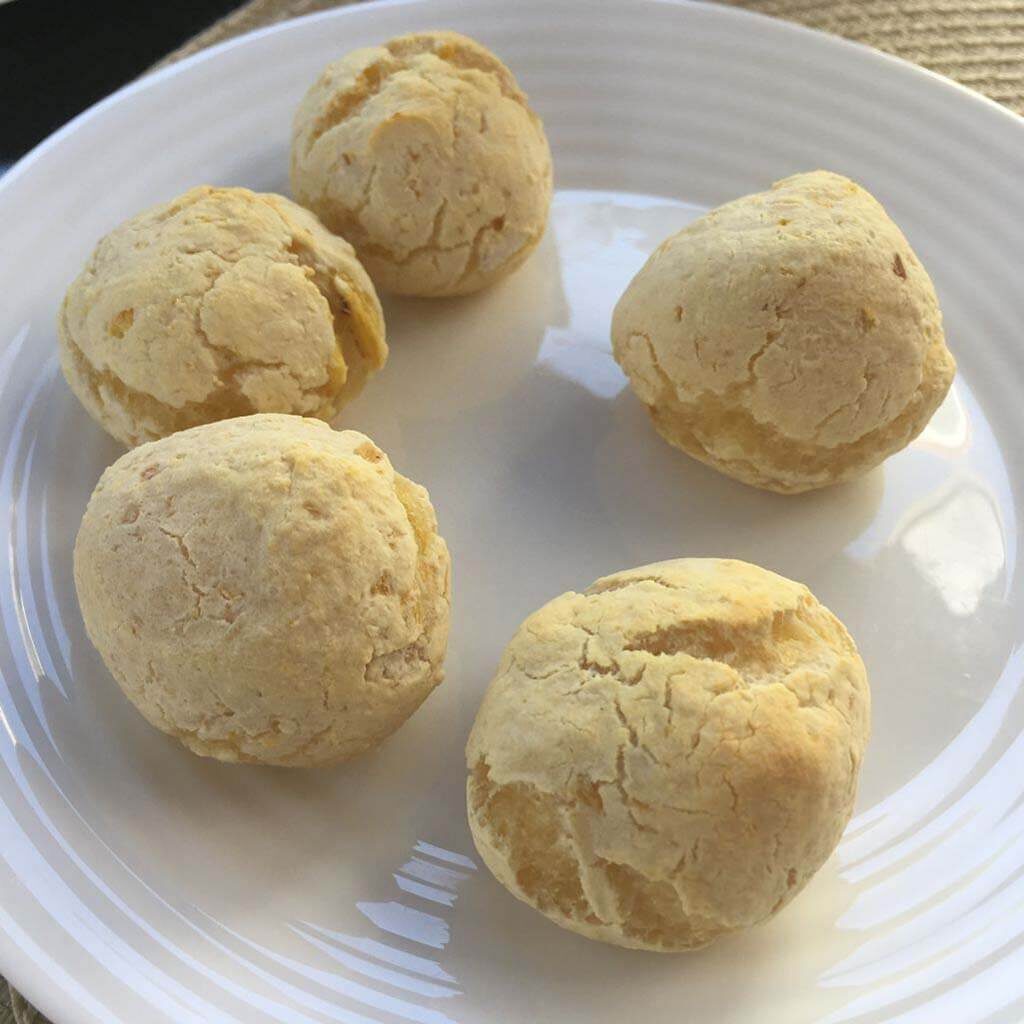
Pic Wendy from The Nomadic Vegan
The name “pão de queijo” means “cheese bread”, and I guess it could be described as a small, round cheese roll. But it’s actually made from cassava flour rather than wheat flour, so the texture is more elastic and chewy than what you’re probably expecting.
The origin of pão de queijo lies with the many African slaves brought to Brazil to work in the mines in the state of Minas Gerais. In Africa, cassava root was (and still is) pounded into dense cakes and eaten as a starchy accompaniment to many dishes.
In Brazil, this was adapted by adding the local cheese produced in Minas Gerais. Pão de queijo is usually eaten either for breakfast or as a snack, and you will find it sold at bakeries and lanchonetes (snack bars), and also in supermarkets. While it originated in Minas Gerais, it’s become popular throughout the country.
Since there is no wheat in pão de queijo it’s a naturally gluten-free food. And nowadays you can even find restaurants and bakeries that make vegan versions of the snack.
For example, Vaca Ateliê Culinário, one of the best vegan restaurants in São Paulo, offers vegan pão de queijo as part of their weekend brunch. You can also enjoy some traditional Brazilian snacks, nuts and cheese with this market food tour.
By Wendy from The Nomadic Vegan
Catch up with The Nomadic Vegan on Facebook here!
17. Aji de Gallina in Peru
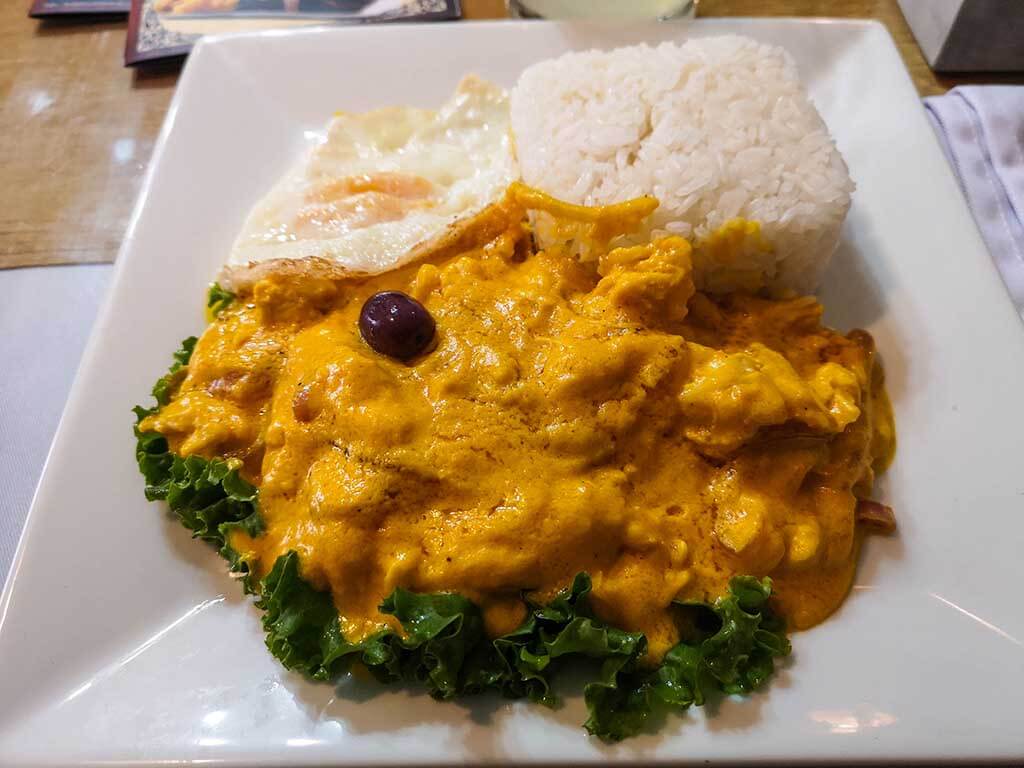
Pic Vicki from Sweet Home Vida
This dish is one of the most popular and, in our eyes, the best meals in Peru. Although Aji de Gallina actually comes from the country’s coast, it can now basically be ordered all over the country.
The dish is pulled chicken, served with a sauce made from yellow Peruvian chilies (“Aji”), evaporated milk, turmeric, almonds, and white bread. Depending on the recipe, Parmesan cheese or pecans are also added to the sauce. This tasty dish is usually eaten white rice, potato slices, egg, and black olive.
The exact origin of the dish is still unknown today. Some believe that it comes from the African slaves that have been brought to Peru by Spaniards. However, others suspect that the dish was influenced by a European dessert dish made from evaporated milk and almonds.
Wherever the dish comes from, today it is deeply rooted in Peruvian culture. It is loved by local families, but also cooked in restaurants, and is considered one of the typical Peruvian dishes that you should definitely try during your visit.
By the way, for everyone that doesn’t like chicken, today, there are also versions available with tuna, shrimp, or egg.
By Vicki from Sweet Vida Home
Catch up with Sweet Vida Home on Facebook here!
18. Arroz Con Leche in Peru
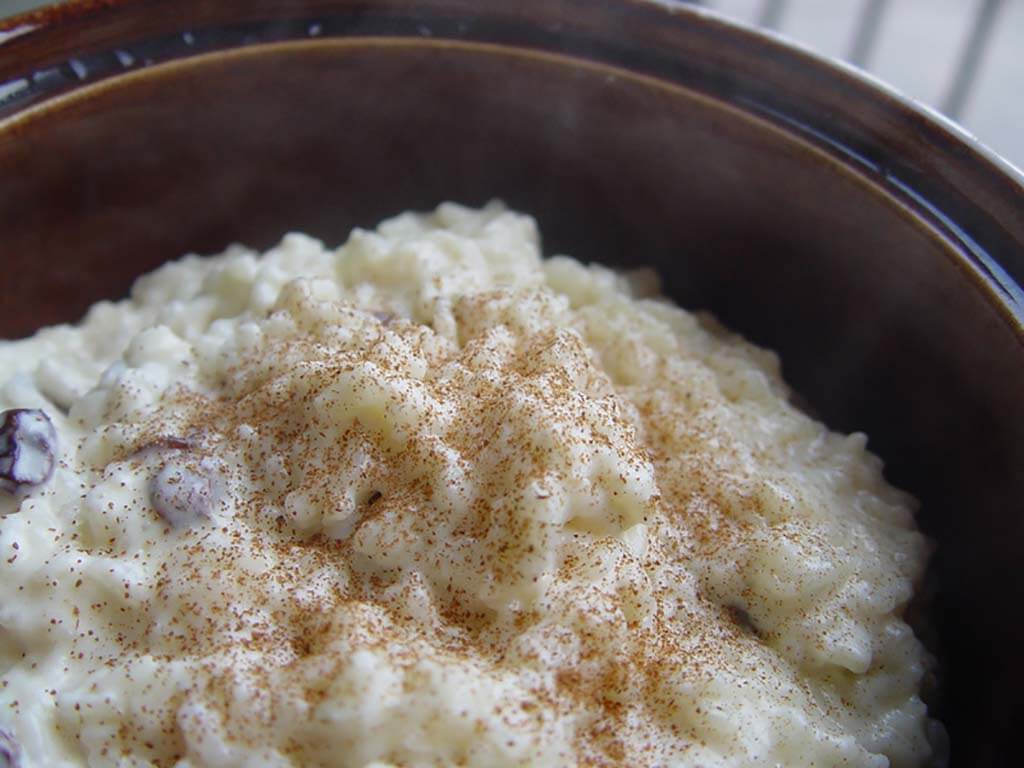
Pic Tanayesh from Shoestring Travel
Arroz con Leche is a very famous Peruvian dessert delight made of rice. History says that it is originated from Spain. Wayback the Spanish conquistadors brought to South America their Arab cooks, recipes, sugar, rice, and milk.
Out of the many recipes, this rice pudding conquered the hearts of the people because of its simple recipe and intense sweetness. Since then it became the staple food in every household, restaurants, pastry shops, street vendors.
It is said that every mom in Peru has at least one secret ingredient while preparing this so every dessert prepared is different yet similar. Its served warm in bowls or glasses sprinkle with cinnamon powder and tastes delicious especially during winters.
For this basic rice pudding ingredients needed are rice, sweetened condensed milk, and evaporated milk. However to make it exquisite things added are grated coconut, raisins, dried apricot, rum, vanilla essence. This is one of the most popular and after a good meal, this dessert is eaten to finish off a great and satisfying lunch.
This South American dessert is so enticing because of its creamy texture, aroma, and sweet flavor that it is very popular among kids and there is a song too called Arroz con Leche which kids sing and play in schools.
By Tanayesh from Shoestring Travel
Catch up with Shoestring Travel on Facebook here!
19. Elote in Mexico
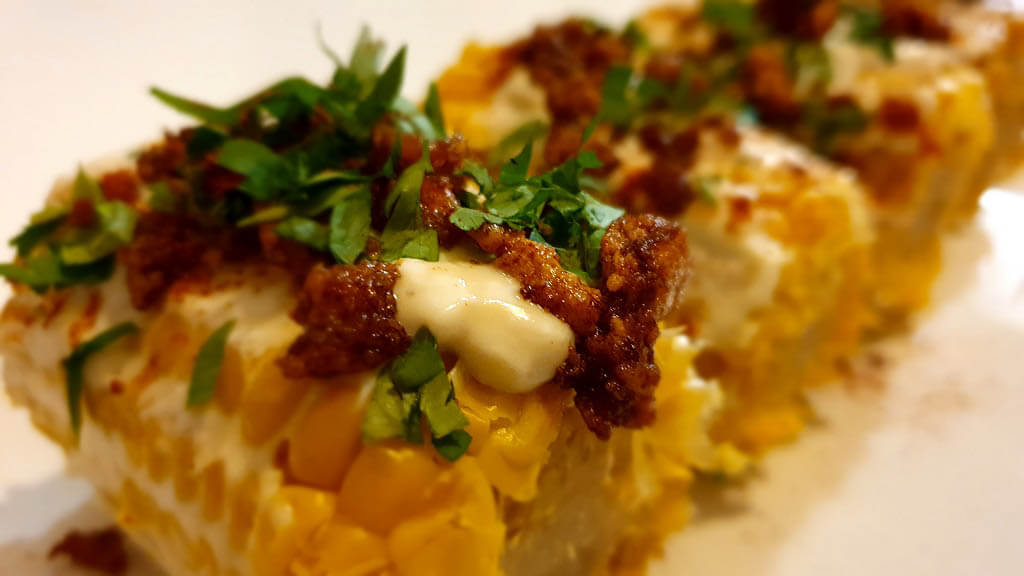
Pic Linn from Easy Way To Vegan
Mexico’s street food is a never delight, but one really simple thing as corn cobs have been made into a culinary experience for all the senses in the best way possible.
Elote is simply corn cobs, grilled or boiled in water greased up with mayonnaise, sour cream, crumbled queso fresco, lime, chili powder, and cilantro. It doesn’t sound half as good as it is, and it’s actually quite easy to make this at home. You can even easily make Elote vegan.
Corn has been an important part of Mexican cuisine for centuries. It actually goes all the way back to the Aztec Civilization. Today, most Mexican food is based on corn in one way or another. Just think corn tortillas.
It’s said that Elote in particular roots from Mexico City. There is also a different way of preparing this Mexican street food, which is removing the corn kernels of the cob and serving it as a soup with all the same goodies as Elote is covered in. This is called Esquites.
By Linn from Easy Way To Vegan
Catch up with Easy Way To Vegan on Facebook here!
20. Garnaches in Belize
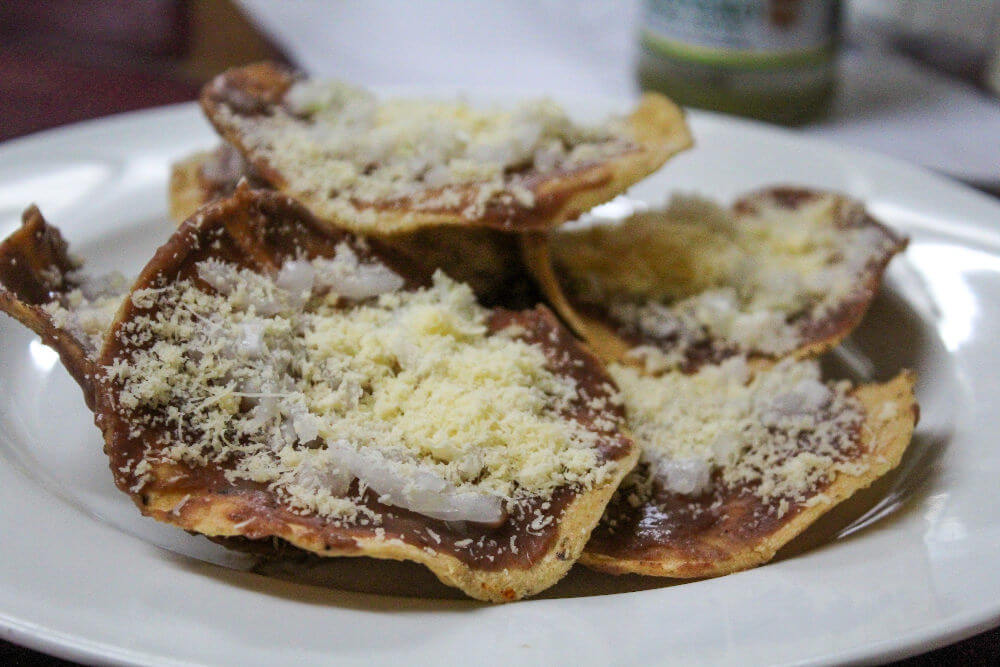
Pic by Martha from Quirky Globetrotter
When traipsing through Belize, little did I think that I would be sampling Dutch cheese on my Belize culinary food tour. Dutch cheese is one of the main ingredients in one of Belize’s iconic dishes, Garnaches.
Garanches are deep-fried corn tortillas that are topped with a layer of refried beans, chopped onion and then a hefty portion of Dutch cheese. The nuttiness of the Dutch cheese and sharpness elevates this “bar food” into a guilty pleasure I’ll be craving for years to come.
In restaurants, garnaches are Belizean’s take on bar nachos. The unique flavors and textures make this dish outshine any other plate of nachos you’ve consumed sober.
Luckily, this snack is relatively cheap to fill up budget-conscious backpackers or when you’re hankering a snack after a long night out filled with ample amounts of Caribbean rum.
Garnaches are also well-known in the neighboring country of Guatemala. Historically, Guatemala adds cabbage and shredded cheese instead of Dutch cheese and chopped onion.
Once you sample garnaches, you’re going to want to feast on other Belizean favorites such as deep-fried conch, ceviche, empanadas, Fry Jacks and other Creole- and Mayan-inspired dishes unlike any other cuisine in the world. Don’t pass up this small country and overlook its culinary uniqueness!
By Martha, The Quirky Globetrotter
Catch up with Martha on Facebook at Quirky Globetrotter!
21. Empanadas in Ecuador
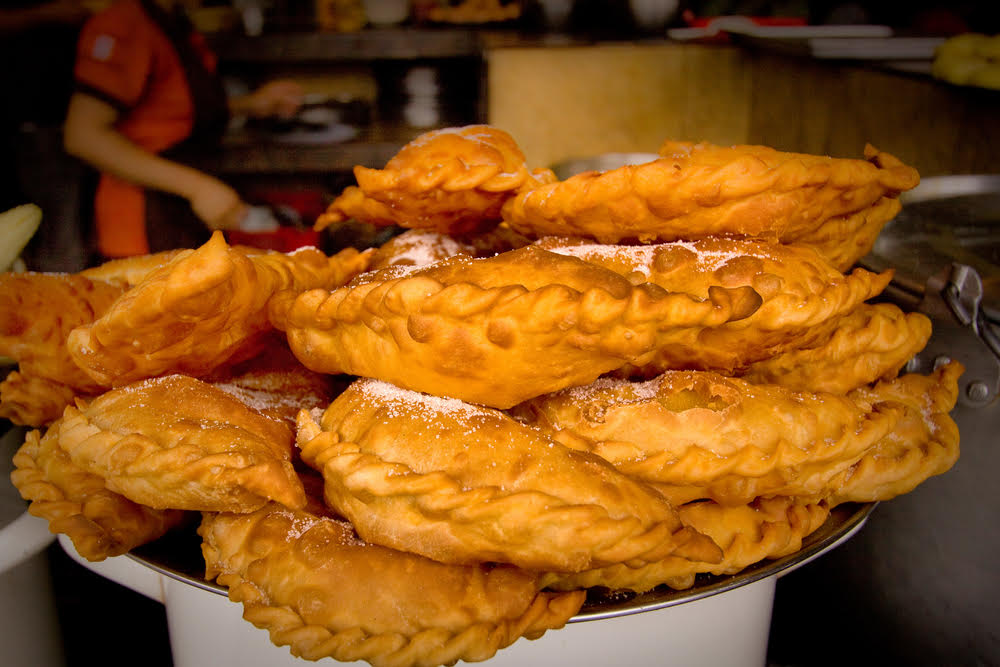
Pic via Shutterstock by Stephanie
A popular Latin American street food, Empanadas are fried bread filled with cheese and meat. Plain cheese empanadas are fabulous but add a bit of vegetable or sausage and they’re just superb.
Like the best street foods, you’ll find empanadas are inexpensive, delicious, and ubiquitous. If you’re traveling Ecuador on a budget, you’ll be happy to enjoy these several times a day. I like to buy extras to keep with me when I need a snack on the road.
Empanadas began as a colonial cuisine, brought over by the Spanish. The first empanadas were made in Galicia in northern Spain. However, each country and region have their own take on this dish.
Empanadas de Viento, are an Ecuadorian specialty. These are filled with cheese but have a sugared coating on the outside. They are the perfect blend of savory and sweet. You simply must try one next time you’re in Quito or Cuenca.
By Stephanie of History Fangirl
Connect with Stephanie on Facebook at History Fangirl
22. Tacos al Pastor in Mexico City
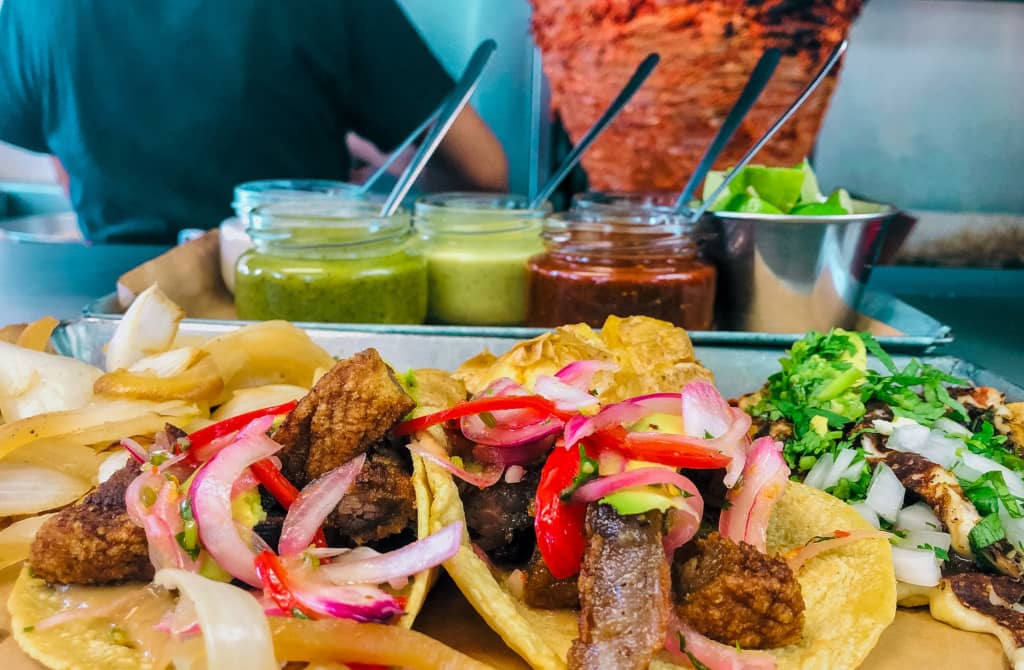
Pic by Shelley of Travel Mexico Solo
There are many distinct varieties of tacos in Mexico, from barbacoa tacos in Hidalgo state to fried fish tacos in Baja California. However, Mexico’s most universally-loved taco is the taco al pastor, one of the best tacos in Mexico City that all visitors must try.
Though these are the quintessential Mexican street food tacos, tacos al pastor have Middle Eastern origins. From about 1885-1935, many Lebanese people immigrated to Mexico, bringing with them their culinary traditions.
One of these was the traditional meat-on-a-spit cooking technique, the way meat is cooked for gyros and shawarmas. Eventually, Mexicans started using it to cook pork meat, and the taco al pastor was born.
To make tacos al pastor, slabs of pork meat are marinated in a mixture of local spices and chiles, then stacked on a metal rod (spit) to form a trompo. Trompo translates to “spinning top,” as in the children’s toy, which has the same shape.
To cook the meat, the trompo rotates slowly past an open flame. There is a whole pineapple at the top of the trompo, and the juice drips on the meat as it cooks to add sweetness.
Taco chefs, called taqueros, skillfully carve the meat in thin slices and place it on a corn tortilla, along with some pineapple. From here, each diner can add diced white onion, cilantro, lime juice and salsa, to create their perfect taco al pastor. Enjoy your taco experience with this tacos and Mezcal tour in Mexico city.
By Shelley from Travel Mexico Solo
Catch up with Travel Mexico Solo on Instagram here!
23. Ceviche in Mexico
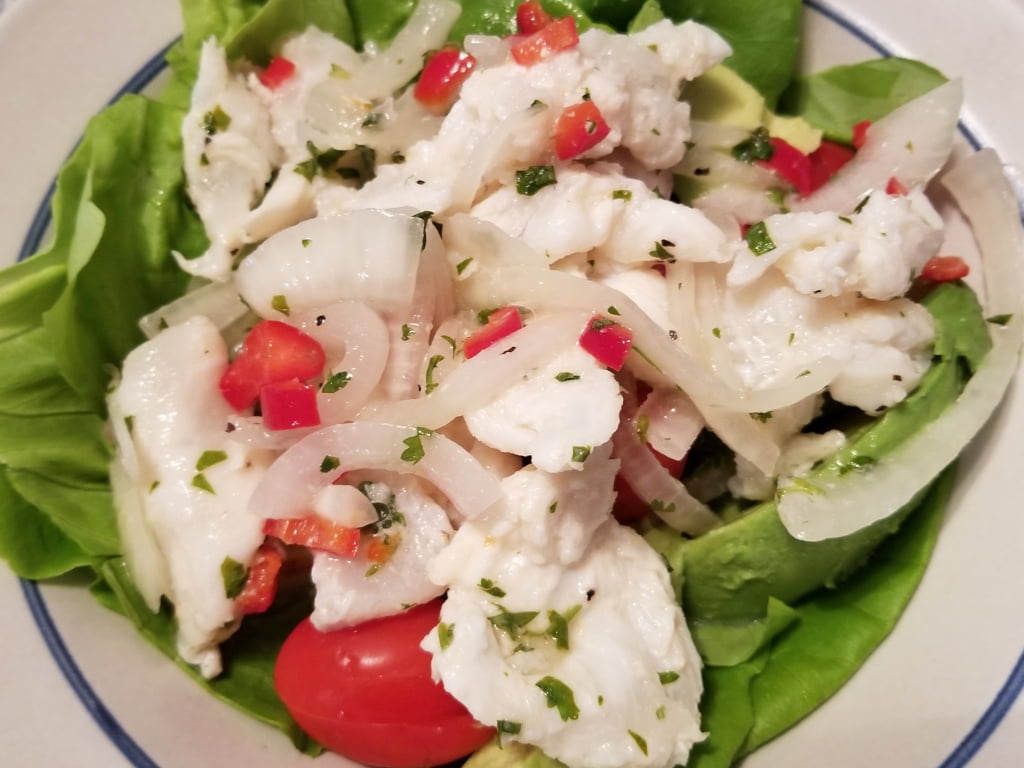
Pic by Donnamarie of Explore the Road with Donnamarie
Ceviche is a traditional way of curing fish chemically using fresh citrus juices instead of heat. Ceviche originated in Peru, South America’s third largest country, over 2000 years ago.
It can be served cold as an appetizer or as a meal with slices of cold sweet potatoes or corn on the cob. It is thought that originally the Incas used the fermented juice of the banana passionfruit to cure the fish.
Then with the colonization by the Spanish, citrus was introduced to the area. Today the raw fish is covered by lime juice for several hours or overnight until the fish becomes opaque and firm. Once opaque, it is mixed with diced tomatoes, jalapenos, onions, cilantro and olive oil. The difference between the Mexican and Peruvian ceviches though is that Mexican ceviches include tomatoes, while Peruvian ceviches don’t.
This centuries-old dish is found in many Latin American countries due to the abundance of local seafood and warm climates for citrus growth. Luckily, now we can also find it in many restaurants around the world.
By Donnamarie from Explore the Road with Donnamarie
Follow Explore Road with Donnamarie on Pinterest
24. Mofongo In Puerto Rico
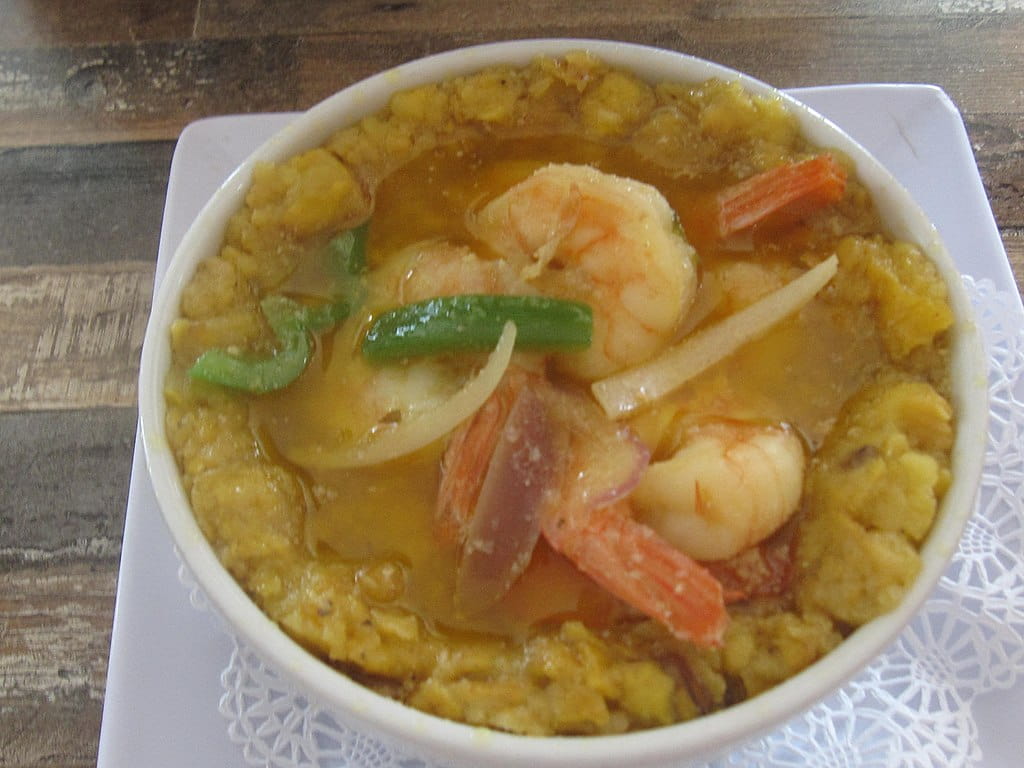
Pic by The Eloquent Peasant
Puerto Rico is known for the vibrant culture, beaches for miles, lively music, water-sports for all, and the happiest people in the world. But, the best reason to visit this Caribbean paradise is the cuisine, a fusion of Taíno Indian, Spanish, and African influences, known as Cocina Criolla.
Mofongo, our family favorite, is created by mashing fried green plantains, garlic, olive oil, and pork rinds in a pilón, which is what we know as a mortar and pestle.
This mouth-watering mixture is molded into the shape of a bowl that is filled with your choice of shrimp, pork, chicken, beef, or octopus seasoned to perfection. Pair this dish with a side of beans and rice and a fresh salad.
While exploring the magical island of Puerto Rico, make sure to taste the local beer, Medalla Light — light, crisp, uncomplicated, and refreshing.
By Jenny B from Traveling Party of Four
Follow Jenny on Pinterest at Traveling Party of Four
25. El Chacarero Sandwich in Santiago de Chile
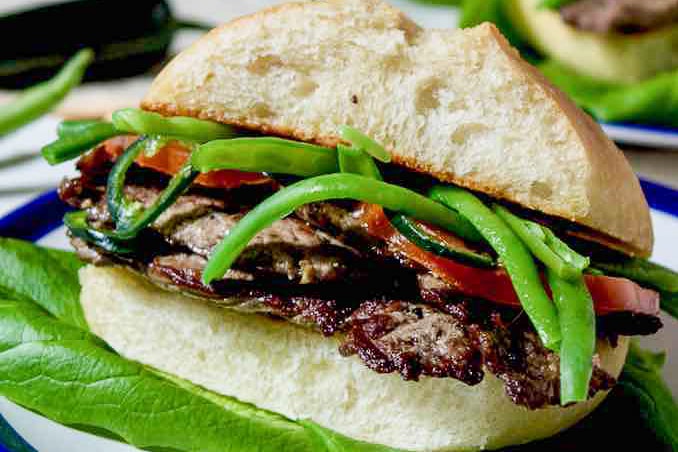
Pic by Roxanne from Faraway Worlds
One of the best things to do in Santiago de Chile is visiting a local sandwich shop. Chile is famous for its sandwiches, and the classic chacarero is on the top of the list.
The chacarero is a simple sandwich. A soft bun is filled with slices of grilled steak, sliced tomatoes, a mound of green beans and a sprinkling of spicy green ají peppers. The overall effect is striking with contrasting colours and the bun usually stuffed to the point where the filling is overflowing.
It tastes delicious too – the beef is a good combination of tender and crispy while the sandwich as a whole is fresh, spicy, soft and just a little crunchy, all at the same time.
These sandwiches are available all over the country and there are different versions (and prices) depending on the establishment, from quick and tasty to more gourmet options.
Regardless, these sandwiches are filling and flavoursome and best enjoyed with a cold beer.
By Roxanne from Faraway Worlds
Follow Roxanne on Facebook at Faraway Worlds
26. Humitas in Peru
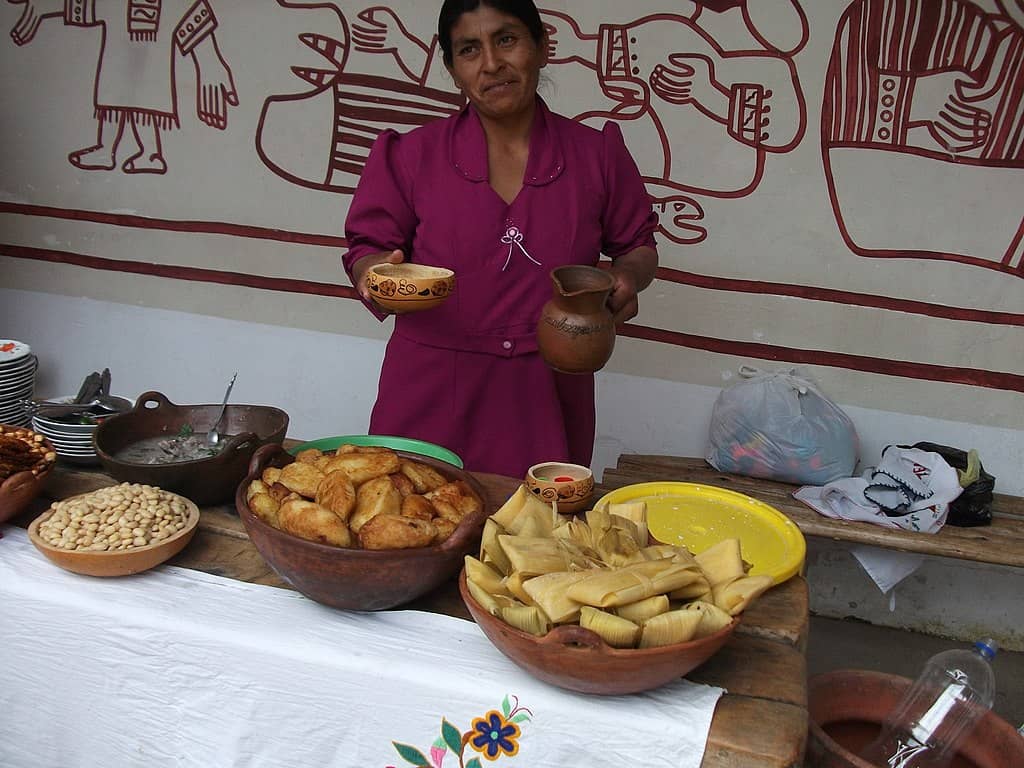
Pic by Miguel Alan from Wiki cc by SA 4.0
When it comes to food, Peru is perhaps best known for two things: potatoes and corn. There are lots of different corn varieties in Peru, and corn is served in many different ways.
One of the most ubiquitous roadside snacks is called choclo con queso, giant-kernelled, mild-flavoured corn on the cob served with a big slice of salty Andean cheese.
Another mealtime staple is mote (pronounced mo-tay), the same giant kernels of corn this time boiled and served loose by the plate-full.
Last but not least are humitas, a popular snack, especially at breakfast time. These are made by preparing a mash of fresh corn which is then wrapped up in the same corn husks the corn was shucked from (very eco-friendly)!
When freshly made, humitas – also called humintas – are usually steamed in their corn husk wraps, but they can be reheated in a skillet later and are extra tasty when the husks get a little burnt and crispy!
The corn filling inside humitas is fresh and slightly sweet-tasting. You’ll often find them with little bits of cheese mixed in, or, for a slightly sweeter taste, anise. ¡Buen provecho!
By Sarah from Nomomente
Follow Sarah and other researchers on Facebook at Nomomente
Wasn’t that a yummy list of the best food in South America and Central America that you must eat? What was your favorite South American dish? And what else should be on this list? Comment and let us know! Or if you have something to contribute, email me.
Other Posts For Your Reading Pleasure
- What to do in Nicaragua with kids
- Doing the Tongariro Hike
- Popular American food to taste
- Kanelbullar and fika
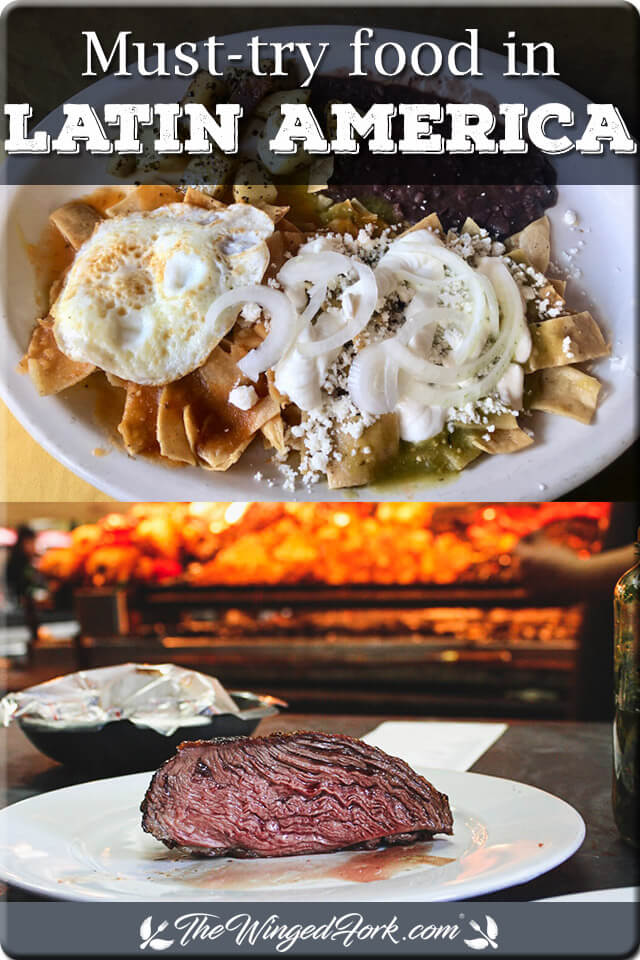
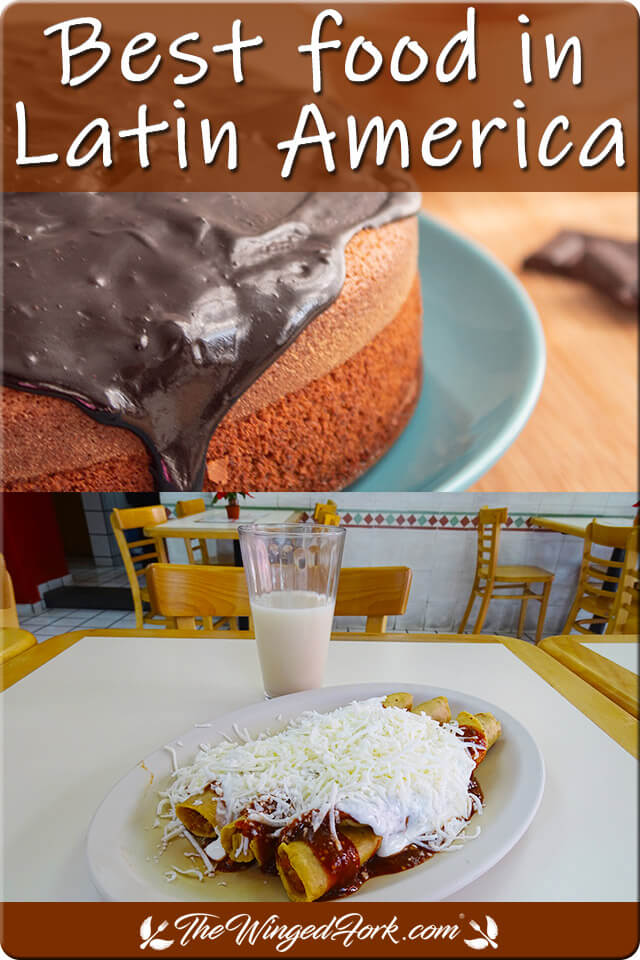
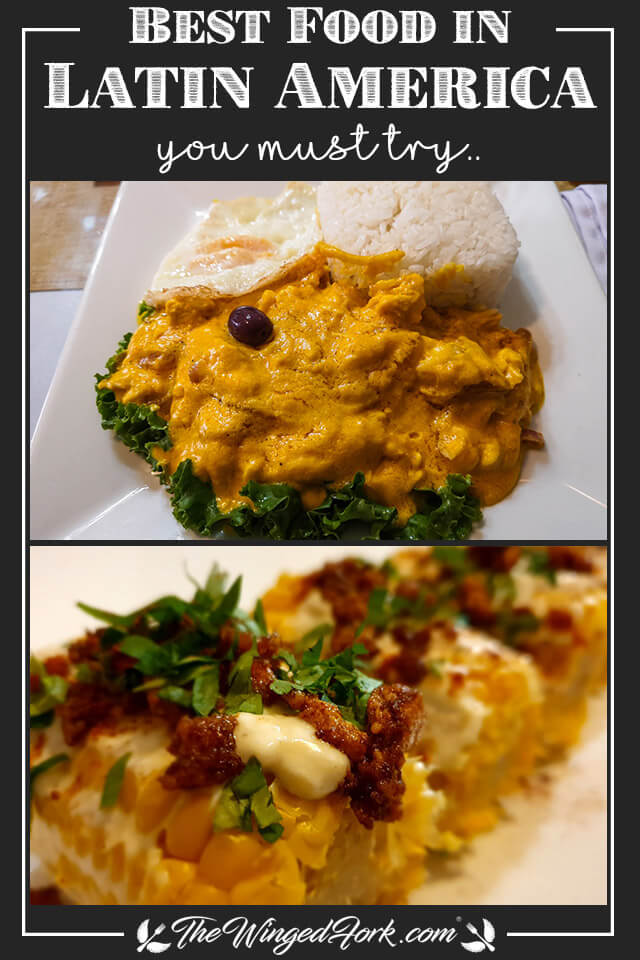

I’m an East Indian foodie and travel blogger from Bombay, India. I’ve travelled across parts of Europe and Asia, and love writing about my experiences with people and cultures. And naturally, I love food, wine, and travel, and have an endless bucket list of places to go to, and experiences I must blog about.
I also love baking and experimenting with food, with a little help from my family. If you must know, my favorite things are nice rainy days, the smell of cakes in the oven, playing in the snow, glasses of wine, and dark chocolate.
More info about me here!
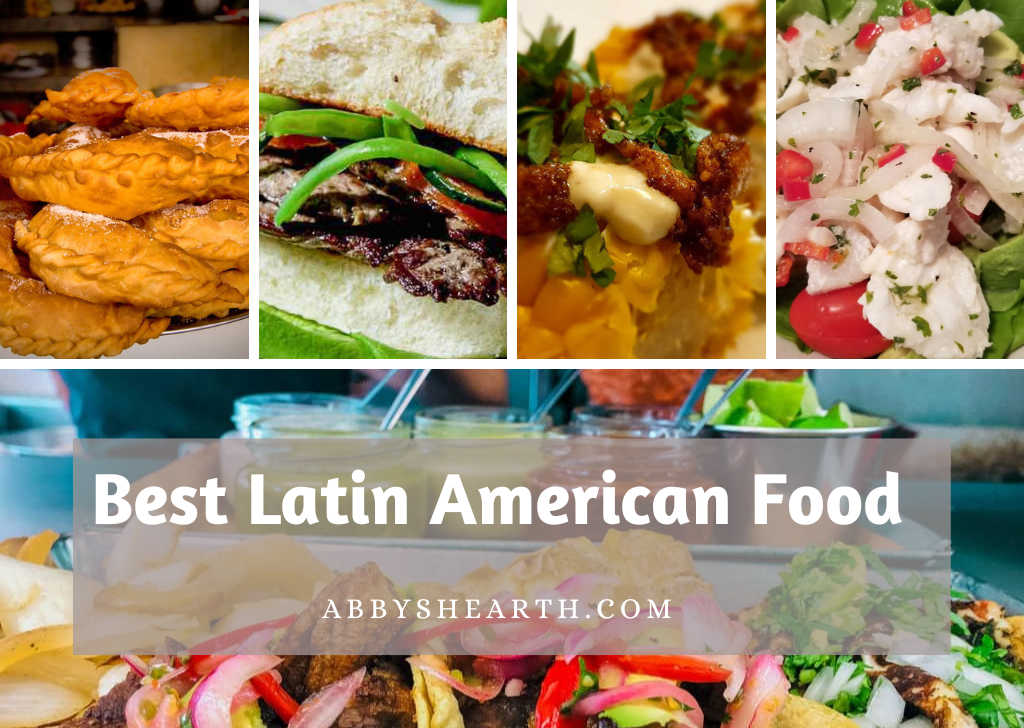



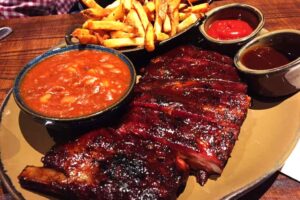

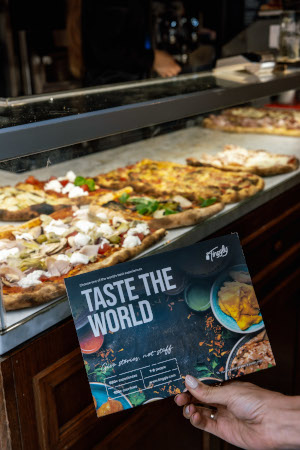
Hi Sarah, thanks for exploring Latin American cuisine! Next time you should visit Nicaragua for a very varied and delicious cuisine with a totally different twist. Nicaraguan cooking is characterized by its simplicity and fresh, local ingredients which makes it very hard to imitate! 🙂 Just try Nicaraguan “Gallo Pinto” and the Costa Rican version of it and you’ll notice the huge difference right away! So, for a formal meal in Nicaragua, try “Vaho” (slow steamed, prime beef with Nicaraguan veggies, topped with shredded cabbage and carrot salad, sprinkled with Nicaraguan “congo” chiles). Or “Sopa de Conchas” (conch soup with chopped onions, chile, and brown sauce). Don’t miss our natural, refreshing drinks: “Semilla de jícaro”, “Pinolillo”, or “Tibio”. For dessert: “Atolillo”, “Cuznaca”, “Buñuelos (yucca fritters bathed in molasses). For a quick and delicious snack try our famous “Quesillo” (melted cheese with pickled chopped onions, and a sprinkle of salt and chile, all wrapped in a thick, warm, corn tortilla).
If you visit, try to come from early December to January, so you won’t miss our national, filled-with-fireworks holidays and because that’s when the weather is nice, cool, and crisp. Hope you come in the near future so you can enjoy the “Country of Lakes and Volcanoes” to see the world from a totally different perspective! Take care and happy new year 2022!
Thank you Tino. I’ve really been wanting to visit. Been saving up those dollars for so long. Or rupees rather, since I’m from Mumbai in India. But I’m going to visit by 2024 and try all the things on this list that my friends suggested and everything you suggested, especially the quesillo which sounds like my sister’s onion sirka topped with cheese.
See you!